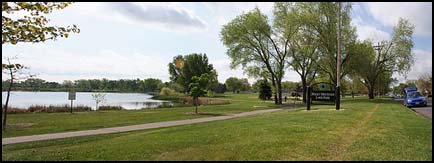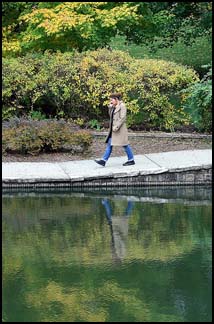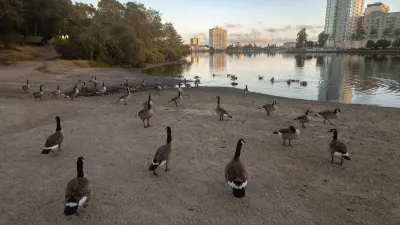Do parks succeed in making people more active? What works and what doesn't when designing and maintaining a park? A recent study by Active Living Research pulls together all the available research. Tim Halbur talks with the man behind the study, Andrew J. Mowen.
The 'synthesis', titled Parks, Playgrounds, and Active Living, was commissioned by Active Living Research, a national program of the Robert Wood Johnson Foundation. Andrew J. Mowen, associate professor at the Pennsylvania State University in the Dept. of Recreation, Park and Tourism Management, explained the purpose of the project. Managing Editor Tim Halbur talked with Mowen in May 2010.
MOWEN: What they were looking for was a summary of the evidence base that have examined the relationship/impact of parks and playgrounds on physical activity. There has been a movement to understand the health role of parks, or re-understanding that because we've always understood that even at the inception of the parks movement in the late 19th century. But there's a revived interest in this issue with the obesity epidemic, with the majority of Americans being physically inactive. So they wanted to understand, what do we really know about parks and physical activity?

TH: Are parks that are shaped for certain activities – trails, tennis courts, soccer fields – more likely to result in people getting exercise? Or are the more Olmsted-inspired open space just as likely to inspire activity?
MOWEN: If you look at raw levels of physical activity – that is, energy expenditures – yes, parks that have more features such as trails, trail connectors to get to the parks, playground features, sport courts, etc., those do tend to result in higher levels of energy expenditure in them. However, those other parks, what we would consider "passive parks" that are more about reflection and contemplation, are also resulting in healthy activities. The activity levels may be moderate, certainly studies have shown that just being outdoors, as opposed to being indoors, corresponds with activity levels. So the simple act of going to a park that's passive, or may be more nature-focused, is still a net positive. Particularly if a larger percentage of the population uses those parks.
TH: You mentioned "trail connectors." That's something I feel like I don't see all that often in urban settings, except in term of Rails to Trails parks, or some of the Olmsted plans.
MOWEN: Trail connectors are becoming a little more common, which is great, because studies show that transportation to parks is a real constraint on park usage, particularly with low-income and minority families. When people have to drive to get to a park, they're less likely to use it. So pedestrian/bicycle connectors is one strategy to get people to parks, and the side benefit of that is that if you're walking 10-15 minutes through your neighborhood to get to a park, that adds to your recommended level of physical activity. You don't even have to be active in that park, it could be a place that you go to meet friends or contemplate. So there has been a lot of promotion of the idea of building more travel routes and trail connectors in these areas.
You take a city such as Cleveland, which is where I used to live. They're working on building trail connectors to their urban parks so it is easier for different neighborhoods to access them. They're calling it an infill strategy, but basically they're reusing land that has been underused and they're converting those into trails and paths.

Image courtesy of Flickr user pink_fish13
TH: Cities have been aware for a very long time that there is a lack of park space in low-income neighborhoods. Has that improved at all?
MOWEN: I don't have any definitive evidence that it has improved. My perception is that it has improved because of the amount of focus that non-profit and public sector organizations have been placing on revitalizing city parks. For example, the Trust for Public Land has a program called The Center for City Park Excellence. They're doing a lot to increase capacity in these urban areas not only of park land but the amount of open space/recreational facilities that are accessible to anyone.
For example, in New York City, school grounds are locked after hours. You can't use school grounds for any purpose, including playgrounds. Mayor Bloomberg has pushed this effort called PlayNYC to unlock those school grounds for public use, which benefits low-income neighborhoods and families near those schools and provides a quicker way of getting access to recreational facilities.
TH: You also talk about how safety and aesthetics encourage greater use.
MOWEN: Well, the early evidence that we have isn't showing a strong connection between safety and the number of visitors. Although if you ask people about place that they feel are safe and whether they use them, there's a high correspondence there. It just seems intuitive that you wouldn't be using a place that you don't perceive as safe.
As far as aesthetics, a lot of that gets to the condition of the facilities, and here's where I see the real disparity in terms of lower-income communities and their use of parks. Not only are there fewer parks for this population, but the condition of those parks seems to be more challenging. It really takes a lot of support from local organizations, whether it's neighborhood associations or volunteers or the actual maintenance staff, to keep these parks maintained.
TH: The report says that the size of the park doesn't have a significant impact on the physical activity levels. Is that right?
MOWEN: Yes, one study found that large parks are no more likely than small parks to be used for physical activity. And I think it really depends on the activity opportunities that you have at these places. If you have a large regional park that is more of a nature preserve/open space and you don't have active features like a trail network in there, then it may not attract high levels of moderate-to-vigorous activity. Nor does it necessarily mean it's going to attract a larger number of visitors. It's really the opportunities present at the park that can drive that visitation level, that can drive that activity level. But by no means am I against large regional conservation parks, they serve their own purpose and have a strong ecological/environmental role to play, which is a different side of public health.
TH: What's your favorite park, and why?
MOWEN: Well, I'll stay local to my community. There is a park I prefer in my home town here, and it's called Circleville Park. It's a regional park, and what I like about it is that it has a trail network that goes through the entire park. I think it's about 20-30 acres. And there are sports fields, pavilions, playgrounds, softball courts, there's even a disc golf course that goes through it. And there are places for reflection, and there are a lot agricultural fields surrounding the park. So you can go to different parts of the park and have totally different experiences, plus you can see the different types of park goers as you're walking around the trail. It's just a great little place to go and easy to get to.

Alabama: Trump Terminates Settlements for Black Communities Harmed By Raw Sewage
Trump deemed the landmark civil rights agreement “illegal DEI and environmental justice policy.”

Study: Maui’s Plan to Convert Vacation Rentals to Long-Term Housing Could Cause Nearly $1 Billion Economic Loss
The plan would reduce visitor accommodation by 25% resulting in 1,900 jobs lost.

Planetizen Federal Action Tracker
A weekly monitor of how Trump’s orders and actions are impacting planners and planning in America.

Wind Energy on the Rise Despite Federal Policy Reversal
The Trump administration is revoking federal support for renewable energy, but demand for new projects continues unabated.

Passengers Flock to Caltrain After Electrification
The new electric trains are running faster and more reliably, leading to strong ridership growth on the Bay Area rail system.

Texas Churches Rally Behind ‘Yes in God’s Back Yard’ Legislation
Religious leaders want the state to reduce zoning regulations to streamline leasing church-owned land to housing developers.
Urban Design for Planners 1: Software Tools
This six-course series explores essential urban design concepts using open source software and equips planners with the tools they need to participate fully in the urban design process.
Planning for Universal Design
Learn the tools for implementing Universal Design in planning regulations.
Caltrans
Smith Gee Studio
Institute for Housing and Urban Development Studies (IHS)
City of Grandview
Harvard GSD Executive Education
Toledo-Lucas County Plan Commissions
Salt Lake City
NYU Wagner Graduate School of Public Service



























